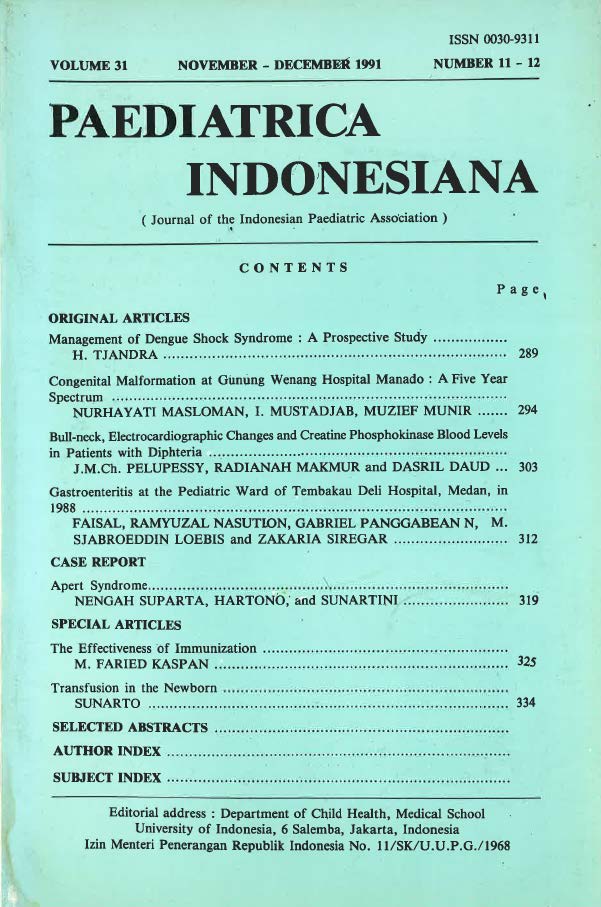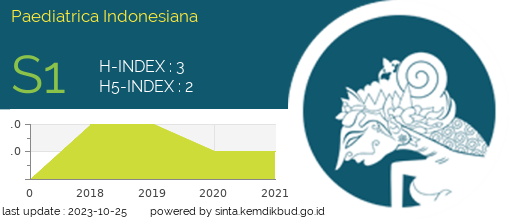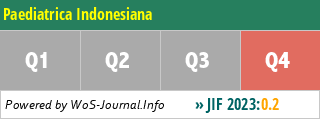Bull-Neck, Electrocardiographic Changes and Creatine Phosphokinase Blood Levels in Patients with Diphtheria
Keywords:
bull-neck, electrocardiographic changes, creatine phosphokinase, diphtheriaAbstract
All paediarric patients with the diagnosis of diphtheria who were seen at the Department of Child Health Ujung Pandang General Hospital from October 1987 to October 1989 were evaluated for bull-neck, ECG patterns and serum creatine phosphokinase (CPK) values. Their ages ranged from 1 year and 2 months to 13 years with a mean of 6.54 ± 3.09 years. Males and females were affected in a ratio of 1:1.
Of 39 patients included in the trial, 28 were classified of having normal ECG and 11 as having abnormal ECG on admission. During hospitalisation, 56.4% of cases showed ECG changes. All patients had raised serum CPK levels on admission. This increase was 14.6 times the normal level in cases with abnormal ECG and only 3.0 times in those with normal ECG (p < 0,01). The highest levels of serum CPK were noted in the first week, then returned to normal in the second week and decreased further in the third week. It became also evident that patients who developed abnormal ECG later on, had already demonstrated an inceased serum CPK level of 5.2 times the normal levels on admission.
Bull-neck appeared in 19 out of the 39 patients. Patients with bull-neck differed very significantly (p <0.001) from those without bull-neck in either the frequency of the occurrence of abnormal ECO patterns or the mean CPK serum levels. Most of the patients (84.2%) with bull-neck had abnormal ECG patterns and mean CPK serum levels of almost 12 times the normal values while only 30% of patients without bull-neck had abnormal ECG patterns and a normal value of mean CPK serum levels.
The mean CPK serum levels differed very significantly (p< 0.001) among the various ECO patterns. The mean CPK serum levels of patients with sinus tachycardia, sinus tachycardia + left ventricle hypertrophy and left ventricle hypertrophy were 11.2, 7.3 and 6 times the normal values respectively.
These findings suggest that an increase of sawn CPK to a certain level may precede the development of abnormal ECG patterns and is valuable for determining the prognosis.
References
2. MUNFORD RS, ORY HW, BROOKS OF, FELDMAN RA. Diphtheria deaths in the United States, 1959-1970, J Am med Ass 1974; 229: 1890-3 .
3. ABDULKADIR J, SIDIK M, ·DJALIL T, SUGIRI. Cardiac complication due to diphtheria in the Dr. Hasan Sadikin General Hospital, Bandung. Paediatr lndones 1976; 16: 517-26.
4. MEURS AAH, ARNTZENIUS AC. Praktishe elektrocardiografie. 1st ed., Utrech-Antwerpen: Scheltema & Holkema, 1981 : 10-9.
5. RAPHAEL SS . Lynch's medical laboratory technology . 4th. ed. London : Saunders, 1983: 165 .
6. BOEHRINGER MANNHEIM DIAGNOSTJCA THERAPEUTICA. Pedoman kerja makro-tehnik , Boehringer Mannheim Gmbh, 1979.
7. NADAS AS. Pediatric cardiology. 2nd. ed. London: Saunders, 1969: 277-8.
8. MORGAN BC. Cardiac complications of diphtheria. Pediatrics 1963; 32: 549-57 .
9. MAIMUNAH AFFANDI, KARJOMANGGOLO W.T. Diphtheria in children in Jakarta. Pediatr Indones 1965; 5: 942-50.
10 . SAMIK WAHAB A, ISMANGUN, PUSTIKA SASTROAMIDJOYO. A selective study of clinical diphtheria myocarditis. Pediatr Indones 1973; 13: 24-30.
Downloads
Published
How to Cite
Issue
Section
License
Authors who publish with this journal agree to the following terms:
Authors retain copyright and grant the journal right of first publication with the work simultaneously licensed under a Creative Commons Attribution License that allows others to share the work with an acknowledgement of the work's authorship and initial publication in this journal.
Authors are able to enter into separate, additional contractual arrangements for the non-exclusive distribution of the journal's published version of the work (e.g., post it to an institutional repository or publish it in a book), with an acknowledgement of its initial publication in this journal.
Accepted 2017-05-30
Published 1991-12-31














